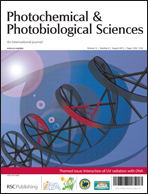Much of the cancer-causing effects of ultraviolet radiation from the sun have been linked to the formation of dimerized DNA bases. These dimeric DNA photoproducts include the cyclobutane pyrimidine dimers (CPDs) and the pyrimidine(6-4)pyrimidone photoproducts [(6-4)PPs]. CPDs are highly mutagenic and are produced in substantial quantities by UVB radiation. These dimers can form between any two adjacent pyrimidines and can involve thymine, cytosine, or 5-methylcytosine. Very recently, a sixth DNA base, 5-hydroxymethylcytosine (5hmC) has been identified and characterized as a normal component of mammalian DNA. Here, we investigated the formation of CPDs at different DNA sequences containing 5hmC following irradiation with UVA, UVB, or UVC light sources. We show that the formation of CPDs at dipyrimidines containing 5hmC occurs at different DNA sequences but is not enhanced relative to cytosine or 5-methylcytosines at the same sequence positions. In fact, in some sequence contexts, CPDs containing 5hmC are formed at very low levels. Nonetheless, CPD formation at 5hmC pyrimidines is expected to be biologically relevant since three types of human skin-derived cells, fibroblasts, keratinocytes and melanocytes, all contain detectable levels of this modified base.

You have access to this article
 Please wait while we load your content...
Something went wrong. Try again?
Please wait while we load your content...
Something went wrong. Try again?


 Please wait while we load your content...
Please wait while we load your content...